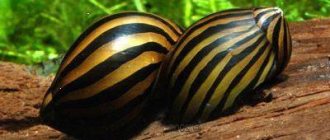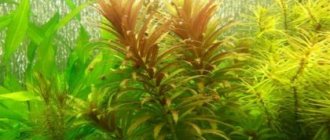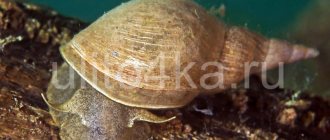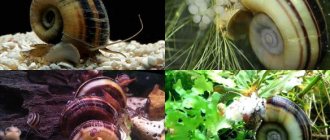Moss in aquariums is nothing new. It has many advantages over other aquatic plants. This is a living decor that decorates the underwater landscape, and a spawning substrate for some fish, and a shelter, and a food supply for shrimp and fry. But most importantly, it has high decorative properties, a variety of shapes and a moderate growth rate. In this article I would like to talk about one of these plants with the interesting name “phoenix”. Let's learn about its features and subtleties of content.
Reasons for popularity
Phoenix moss belongs to the subclass of Briaceae green mosses, order and family Hypnaceae, genus Taxiphyllum. In the literature it can also be found under the names:
- "Phoenix moss"
- Fissidens Fontanus,
- fissidens fontanus and phoenix tail.
Aquascapers (including beginners) love it for its ease of maintenance, rapid growth and excellent decorative qualities. The shoots of this moss look like a frozen green fountain, hence one of its names.
general description
This moss is a representative of the genus Taxiphyllum , belonging to the Hypnidae moss family and the Briaceae subclass. Its official name in Latin is Fissidens fontanus. The genus Fissident (translated as “split tooth”) includes more than four hundred species, making it one of the largest among all mosses.
Even in Russian, this plant is often called “fontanus”. This name was given to it because of the unusual shape of the shoots, as if flowing like a fountain from stones and driftwood.
Phoenix because of his appearance . If you look closely at its leaves, you can easily find a resemblance to the feathers of the fairy-tale phoenix bird. This name - Phoenix moss - was given to it in Japan and Thailand, where it arrived from its homeland - North America. In other countries where it grows, people have different associations, for example, in Poland it is compared to a fox's tail.
Under natural conditions, this plant prefers ponds and rivers with standing water or slow flow. If the water level changes, the moss floats to the surface. During dry periods it does not die, adapting to a small amount of moisture. Its tenacious roots allow it to attach itself to nearby snags, rocks and tree trunks. But he is most comfortable in the lowlands, where the last drops of water still remain.
https://youtube.com/watch?v=HhlgAx-YGPQ
Although it is not able to grow on land without bodies of water nearby, it still has its own original way of moving on the ground. It grows onto mollusk shells and moves to where the crustacean crawls. This allows it to change its habitat if the old one has dried out, or simply spread wider.
The shoots of fontanus moss reach 2.5 cm. Its narrow leaves, alternately located on the stem, have pointed tips. As they grow, the branches sag more and more, giving the plant a resemblance to a ball or fountain that has frozen during operation.
Due to the large number of rhizoids (thread-like processes), the phoenix can attach to almost any surface and feel great on it. It does not require a garter, since it itself is firmly attached to the substrate. This quality is indispensable in landscape design, because thanks to it, the fountain can be placed on almost any decorative element.
Shoots of fontanus moss reach 2.5 cm, giving it a ball shape
What does phoenix moss look like?
The length of its branches reaches 2-2.5 cm. 2-mm leaves are alternately located on the stems. Each leaf is elongated, narrow, pointed at the end. The shoots usually hang from stones or driftwood and are very reminiscent of willow branches.
Fissidens fontanus has a lot of rhizoids (special thread-like formations). That is why it can attach quite easily and firmly to the substrate and does not require constant garter. Each bush of this moss is spherical in shape and dark or light green in color.
Useful lifehacks
To promote better plant growth, we offer advice from experienced aquarists:
- The Phoenix's rhizoids, although powerful, are not as strong as those of most representatives of its kind. Therefore, it should be fixed extremely tightly using improvised means.
- Use cotton thread with extreme caution. If there are fish in the aquarium, they can get hurt or get tangled in knots.
- When installing a filtration system, it would be a good idea to get a “flute” nozzle. This device allows the water flow to be evenly distributed. In areas with strong currents, the fluffy bushes fall apart.
- To remove suspended particles that have a detrimental effect on the appearance of the moss, you need to install an internal filter with padding polyester filler.
- Due to the fact that the Phoenix moss leaf is quite large, this plant can be kept together with algae eaters.
- When growing aquatic mosses, you should be extremely careful with the application of phosphate-containing fertilizers. They contain salts of orthophosphoric acid that are harmful to bryophytes.
Phoenix moss in aquarium design
This plant has very great potential. You can experiment by planting bushes in different places in the aquarium and create very interesting views and landscapes.
The main thing is that they fit harmoniously into the overall composition. And if you don’t like something, moving them won’t be difficult.
This “grass” will look good both in the background and in the foreground. Although the second option is more often recommended.
Moreover, it is better to place it not in the corners, but in the so-called “focal points” - these are the places where we involuntarily focus our attention. For the phoenix's tail always stands out, even against the background of other equally beautiful mosses.
There is only one exception to this rule - a reservoir completely planted with fountainus.
Another very important point: the shape of the bush of this moss cannot be adjusted, no matter how you plant it or how you cut it. This is the way it grows. It will always be a spherical bump.
What else can be done with the participation of phoenix moss:
- Place fluffy tussocks on higher elevations.
- Decorate stones.
- Fill the voids between the driftwood.
- Place the moss in the central part of the aquarium and allow the miniature fountains to spontaneously grow in all directions.
- Build a hanging garden.
In general, there is huge scope for experimentation here. The main thing is to maintain balance and not lose common sense.
Distribution area
The epiphyte is widespread in northern America and Europe.
Phoenix moss grows both in wetlands and in reservoirs with crystal clear water. Less common near waterfalls in fast-flowing river sections. Thanks to its strong rhizoids, this plant can often be seen on damp stone walls or on the surface of stones located near streams. It grows predominantly submerged in water; it is less common above the water surface.
What conditions will be optimal for keeping
Phoenix moss is very undemanding to living conditions and does not require complex care. Main attention should be paid to the following points:
Water parameters
- The temperature range in which a phoenix can normally exist is quite wide (from 15 to 30 degrees).
- The most suitable acidity is from 5.5 to 7.5.
- The optimal hardness is no less than 5 and no more than 9, but it will survive even with increased hardness.
If the indicators go beyond these limits, then it will still survive, but it will slow down very much or even stop growing.
Cleansing . The composition of the water is not critical, but its purity is important. There should be a minimum of suspended particles. If you let the moss grow and do not clean it, then all the dirt and silt will settle on its shoots. Eventually it will become overgrown with algae and die. Excellent cleaners for this case are shrimp, which remove both debris and algae.
- There may be a weak current in the aquarium.
- Regular water changes of 30-50 percent are advisable.
- Lighting is allowed both weak (0.3 W/l) and bright direct intense (1 W/l). However, you need to remember that in the shade this moss darkens and becomes less bright.
To achieve fast growth and a rich light green color, you need adequate lighting, CO2 and liquid fertilizers.
Combination with other mosses
Phoenix coexists well with other types of mosses. Using this feature, you can create even more design variations in your aquarium. Here are some options for plant neighborhoods for it:
- Riccia is an original type of moss, often used in decoration. Its stems are filled with air, which allows it to float to the surface. If its roots are attached to the ground, then it is a beautiful island. Like the phoenix, it easily adapts to almost any conditions, but most of all it loves well-lit places with a high content of carbon dioxide.
- Java moss - this species is familiar to almost any aquarist, is widespread and is sold in any store. His unpretentiousness and versatility are qualities for which he is loved and appreciated. It grows slowly, but begins to actively grow after cutting. Capable of creating carpeting, also well suited for small landscapes.
Java moss will work well with phoenix moss - Christmas moss is another species with an original name. It got its name because of its unusual shoots, similar to spruce branches. Adapts well to any conditions, but prefers good lighting. Carbon dioxide does not affect its development. Like the phoenix, it becomes an excellent neighbor for shrimp and a substrate for fish spawning.
- Monosolenium tenerum - similar in appearance to Riccia, but much larger in size. It grows well in any environment and is easily propagated by division, so it is suitable even for beginner aquarists. It needs good water filtration, its preferred temperature is up to 25 degrees, but the lighting can be anything.
Using these types of moss together with phoenix, you can create unique compositions in your aquarium and admire its appearance. You can find other types of vegetation that are more attractive to a particular aquarist - Fontanus can coexist with almost any of them.
Phoenix moss propagation
To propagate this plant, just take its branches and plant them on any snag, stone or net. On
At first they are tied with cotton threads. Over time, they rot away, and the moss becomes attached to the base.
In conclusion, all that remains is to advise you to be careful when purchasing. Carefully inspect all branches, paying attention to their quality. Buy only healthy ones and under no circumstances take plants with the slightest signs of dying. We are sure that phoenix moss will definitely decorate your aquarium, making it elegant, unique and at the same time natural.
Reproduction and planting
In nature, large phoenix moss reproduces by spores that form in a seed pod called a sporangium. Once ripe, it bursts and the seeds land directly on the leaves of the mother plant, where they take root. This process ensures the constant replacement of old individuals with new growth.
If you want to artificially propagate phoenix moss in an aquarium, you can simply divide one bush into two or more parts. Having separated the bunch from the parent plant, you need to attach it using thread, fishing line or mesh to the surface on which it is to be planted. In just a few days, it will no longer need artificial fastening - it will cling to the soil with its own roots and over time will begin to cover an increasingly larger area.
To propagate phoenix moss in an aquarium, you can simply divide one bush into two or more parts.
Before planting a new plant in the aquarium, you need to carefully examine its appearance. If there are brown, withered leaves or algae on it, they should be removed.
When purchasing a phoenix in a store, you need to buy only healthy specimens. If even the slightest part of the plant begins to die, this is a bad sign.
Moss can adapt quickly to a new place, but this does not always happen. This process may take several weeks. Only after this the phoenix will begin to grow.
For better growth, it is recommended to trim the plant regularly. This procedure can be performed with ordinary scissors, cutting off 2 cm of growth. After shearing, the phoenix becomes denser, grows faster and wider. In addition, this helps prevent the lower parts of the moss from rotting.
In general, this type of moss grows much slower than its counterparts, but is famous for its longevity.
How to attach Fissidens Fontanus to decorations
Photo: Fissidens Fontanus moss attached to a piece of driftwood.
They have the qualities of strong attachment to stones and snags. Mainly used for foregrounds, for example, you can create an entire hanging garden. Fissidens Fontanus is in great demand in decorations due to its branches, which very picturesquely hang from driftwood or stones, forming a fountain of greenery. All you have to do is secure a small amount of moss with a cotton thread, and in a short period of time you will have a rich piece of decoration. Even in a small aquarium, the decorative characteristics of the moss Fissidens fontanus make it possible to create the desired shapes.
Possible problems during cultivation
When growing a phoenix, practically no difficulties arise, but it is important to take into account certain nuances so that everything continues with the same dynamics. If you also deal with large algae along with moss, the former will be weakened and will not be able to develop well, so you should abandon large plants. And also it cannot be grown together with shellfish, because of which the moss dies; they eat fragile twigs, so the plant cannot recover. If you notice areas with string algae, they should be cleaned immediately.
The level of water quality is a decisive factor during moss development. Experts emphasize that the aquarium must have soil, since it contains the nutrients necessary for growth.
Sometimes moss can grow quickly, but this does not indicate quality, so timely pruning will allow you to control this process and get beautiful decorative landscaping. In this case, you can use the branches to transplant them into other containers.
Appearance of moss Fissidens fontanus
Moss branches grow up to 2 - 2.5 cm long, the leaves are elongated, narrow with a pointed end, alternately located on the stem. The shoot of Fissidens fontanus has the remarkable property of hanging from snags and stones, resembling a willow twig.
Being in the shade, Fissidens fontanus loses its brightness of color and becomes an order of magnitude darker. But if you provide “Phoenix moss” with sufficient lighting, the required amount of CO2 and liquid fertilizers, the moss will delight you with rapid growth and a rich light green color. Fissidens Fontanus is characterized by the presence of many rhizoids, which allow it to attach to any objects without additional effort. Moss does not require constant garter. It grows not slowly, but not too quickly, it all depends on the conditions. An excellent place for refuges for shrimp fry.
Plant care
In an aquarium, the plant must be properly cared for. Otherwise, the plant can grow quickly and spoil its appearance. During the growing process, you should follow simple recommendations:
- water temperature is not lower than 15 degrees. Otherwise, the phoenix will grow slowly and the color of the leaves will become dull;
- Fissidens prefers an average acidity level of no higher than 7.5 pH;
- water should have neutral hardness;
- Phoenix moss can grow in any water, but it is important to keep it clean. Often, if the water is not changed in a timely manner, the crop becomes covered with a sticky coating or blue-green algae;
- regular supply of carbon dioxide. Special equipment is used for this. Carbon dioxide speeds up the growth of the phoenix and gives it a bright color;
- The container with fish should be regularly illuminated. Otherwise, the culture grows pale and weak.
In order for the plant to have an attractive appearance, special fertilizers are often used. Such nutrients serve as bait not only for plants, but also for aquatic inhabitants.
Key Mosses Needed for Aquascaping
- Javanese - Taxiphyllum barbieri.
This is the most affordable aquarium moss from East Asia, versatile and unpretentious. It is used to create small landscape forms, such as carpeting, the growth rate is low, it is easy to trim (it produces dense growth after removing old shoots).
- Christmas moss - Christmas Moss, Vesicularia montagnei.
The Brazilian plant (which came from Japan, where it is called Amazonian), fast-growing, eye-catching with its flashy green hue is a real treat in the aquarium.
- Monosolenium tenerum (erroneously called Pelia).
Aquarium moss is from the Pacific countries of the Far East, it is found in India, China, Japan, and grows in Hawaii. Unpretentious to the conditions of detention, its layered structure, giving coral-shaped forms, makes it possible to create various landscapes even for an inexperienced aquarist.
- Riccia fluitans - Riccia.
A very interesting form of moss - it tends to float if not tied down. Ideal substrate for fry. It takes a lot of light and carbon dioxide to see the wild beauty of the thalli.
- Phoenix moss - Fissidens fontanus.
A tender plant native to America. It began to be used as an aquarium culture in the Russian Federation quite recently (at the beginning of the 21st century). It is unpretentious in maintenance, forms landscape forms at will, and does not particularly strive to grow.
Benefits of the plant
An aquarium with moss has many advantages. The most important ones include:
- Mosses have the ability to saturate water with oxygen. Air bubbles accumulate in the leaves and provide an additional source of oxygen for fish;
- Phoenix contains the necessary nutrients for the development of aquatic life;
- grows quickly and can form small islands in a short time;
- often used by fry as a secluded place. Also, fish lay eggs between the branches of phoenix moss.
To prevent vegetation from becoming clogged, it is recommended to keep cleaner shrimp in the aquarium. Such aquatic inhabitants make it easier to maintain the crop and reduce the risk of unwanted algae.











